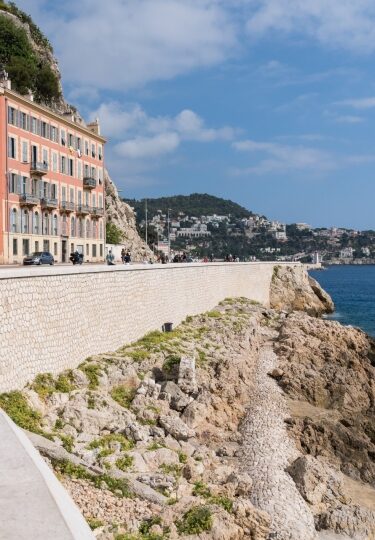It’s not difficult to find delightful things to do in Nice, France. This laid-back city, located on the Bay of Angels along the French Riviera, enjoys more than 300 days of sunshine per year, making it perfect for sun worshippers.
And for the culturally inclined, the history here runs deep, dating back to the Greek Phocaeans, with strong Roman influences as well.
Nice is a magnet for devotees of the beachside riviera lifestyle. You’ll also encounter a surfeit of wonderful local food and wine, some of which comes with a dash of Italian culinary flair, the influence of nearby Italy.
Here are some of the best things you can do in Nice.
Explore the Old Town
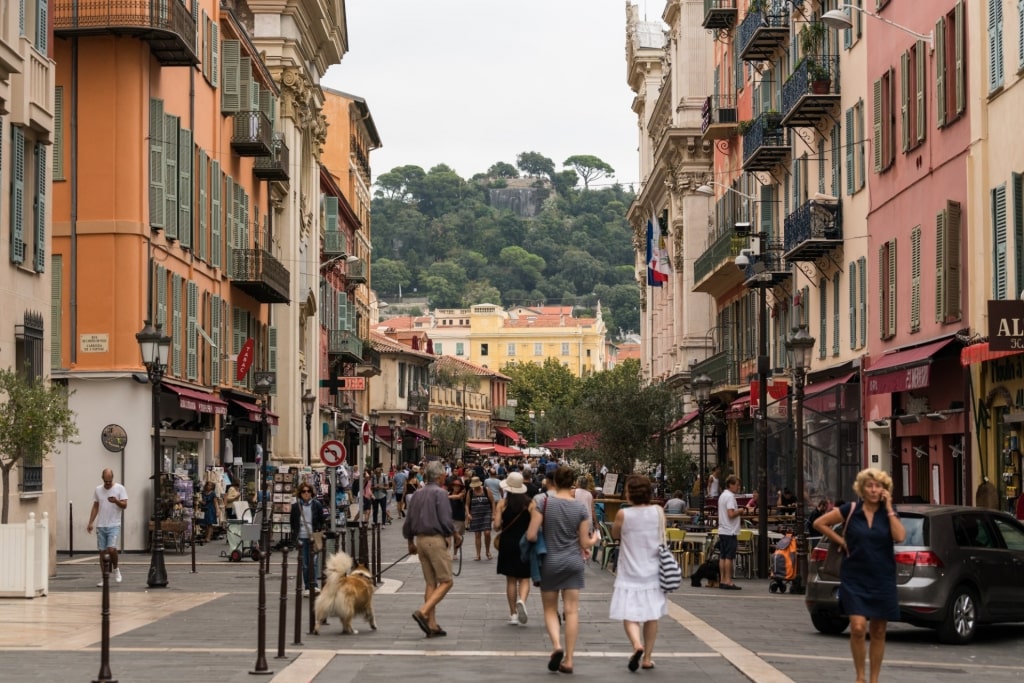
Old Town
The Old Town of Nice, or the Vieille Ville, or Vieux Nice, is one of the best places to visit in the South of France. It will likely be one of your main stops, which makes sense, as you’ll find plenty here to keep you occupied.
The slender lanes in the Old Town are given shape by the tall, shade-giving apartment buildings here, marked by their distinguishing shuttered windows.
Vieux Nice, located below Castle Hill, is perfect for meandering sightseeing strolls. You’ll pass by old churches, art galleries, boutiques, and brasseries, plus an assortment of shops.

Cathédrale Sainte-Réparate
As you wander, check out the St. Francis Market fish market along Saint-Francois Square, where you can see how the locals procure their meat and fish. Of course, you’ll want to drop into the Cathédrale Sainte-Réparate, and the big flower market too.
If you have a sweet tooth, Patisserie Henri Auer confectionery, located next to the Nice Opera House, has been in business since 1820 and is the spot for candied fruits, quality chocolate, glazed nuts, and other sugary delights.
Visit Cathédrale Sainte-Réparate

Cathédrale Sainte-Réparate
While you’re in the Old Town, make your way over to Rossetti Square to visit Sainte Reparate Cathedral (Cathédrale Sainte-Réparate).
Construction on this baroque church got underway in 1650, with work continuing over the decades until the space was consecrated in 1699.
Saint Reparata is the patron saint of Nice. She was a young Catholic Palestinian girl martyred by the Romans for her faith.
One story says that when she was killed, her soul transformed into a dove, then immediately took flight. Another legend details how her body was set on a raft, then guided by angels to Naples, which is how the Bay of Angels got its name.

Cathédrale Sainte-Réparate
Today, Sainte-Réparate is a brightly decorated cathedral, with a baroque façade added during the 1800s. You’ll find ten different ornate chapels inside. The cathedral’s central high altar is dedicated to Saint Reparata and contains some of her relics.
Enjoy the Flower Market at Cours Saleya
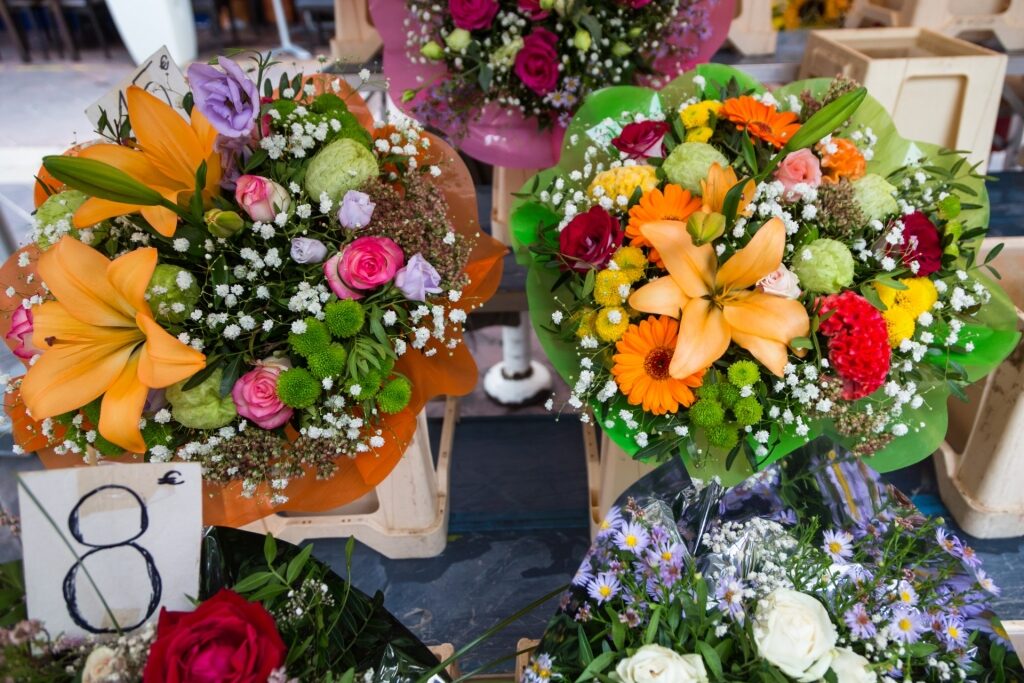
Cours Saleya
Flowers, spices, trinkets, and a riot of color make the Cours Saleya thoroughfare’s flower market (Marché aux Fleurs) a powerful attraction to anyone drawn in by open-air bazaars.
Located in the Old Town, Cours Saleya Flower Market is full of flowers to browse and buy. Vendors at the Fruit and Vegetable Market here will be more than happy to sell you some local produce as well.
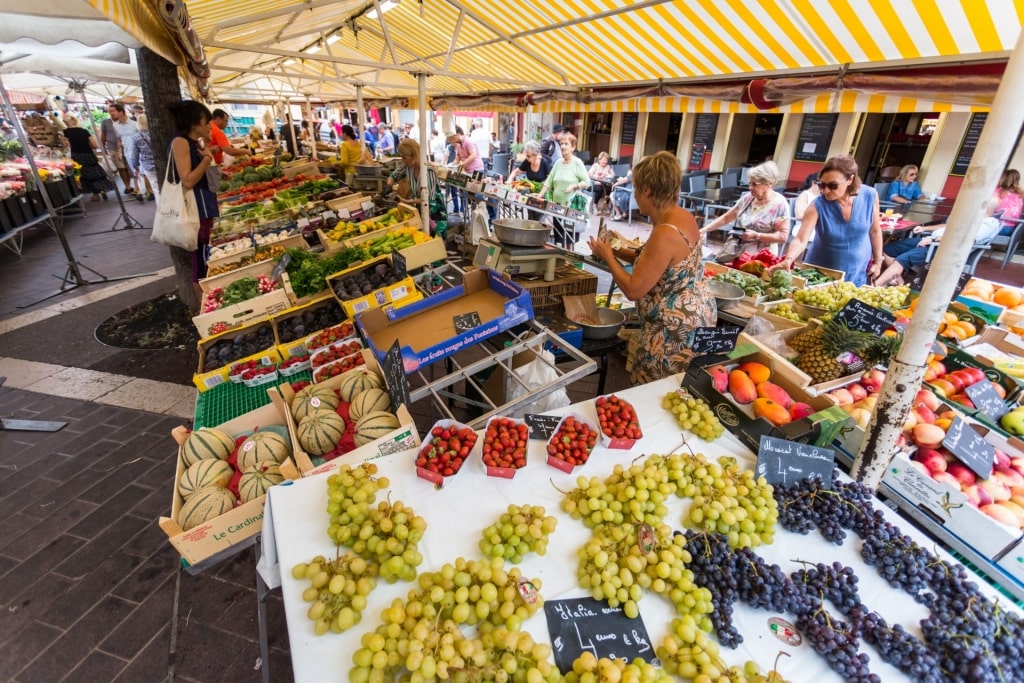
Cours Saleya
You can also pick up other French souvenirs such as dried spices, baked goods, and other tasty nibbles while you peruse the stalls. Cours Saleya comes with bars, sunlit cafés, and restaurants nearby where you can stop for a drink or dine out while steeping yourself in this picturesque marketplace’s floral ambiance.
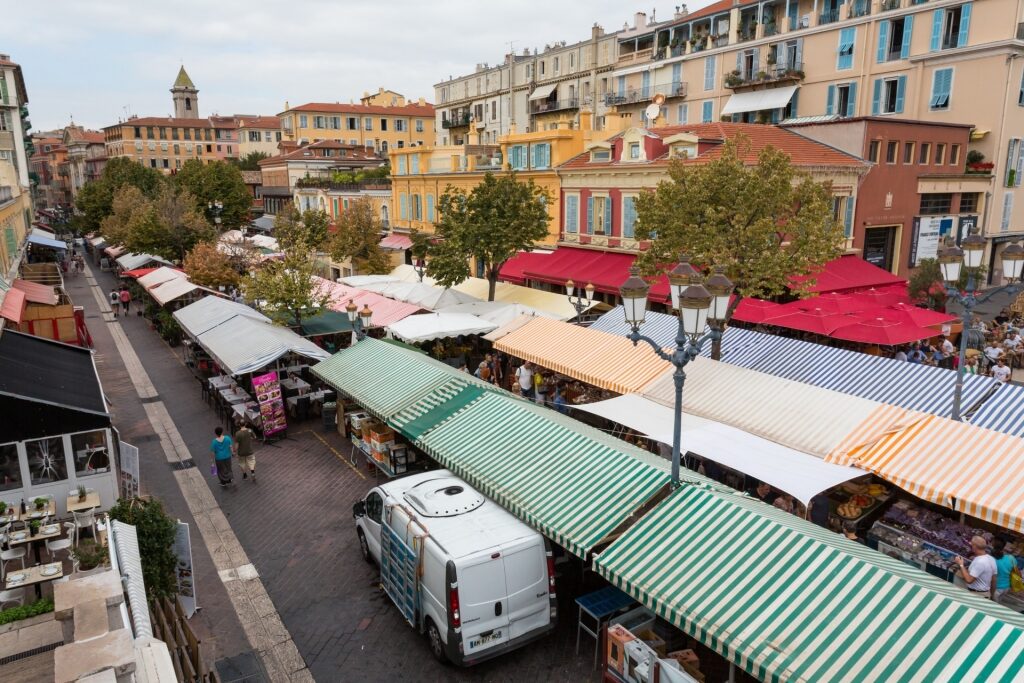
Cours Saleya
In addition to the Marché aux Fleurs, Cours Saleya hosts an antique flea market on Mondays, plus other types of markets at different times, like the evening artisanal crafts market.
Drop by Cathédrale Saint-Nicolas de Nice

Cathédrale Saint-Nicolas de Nice
Nice’s Saint-Nicolas Cathedral stands out in a country full of elaborate churches because Cathédrale Saint-Nicolas de Nice is actually a Russian Orthodox cathedral.
Saint-Nicolas is the largest Russian Orthodox cathedral outside of Russia. The structure, with its bulbous green domes, was commissioned by Tsar Nicholas II to service the growing Russian community in this part of France. Today, the building and the land it occupies belong to the Russian State.
Saint-Nicolas is a working cathedral, located on Av. Nicolas II. If you’d like to learn more about its design, by Russian architect Mikhail Preobrazhensky, you can opt for a guided tour to dig deeper into this church’s fascinating history.
Saunter Down the Promenade des Anglais
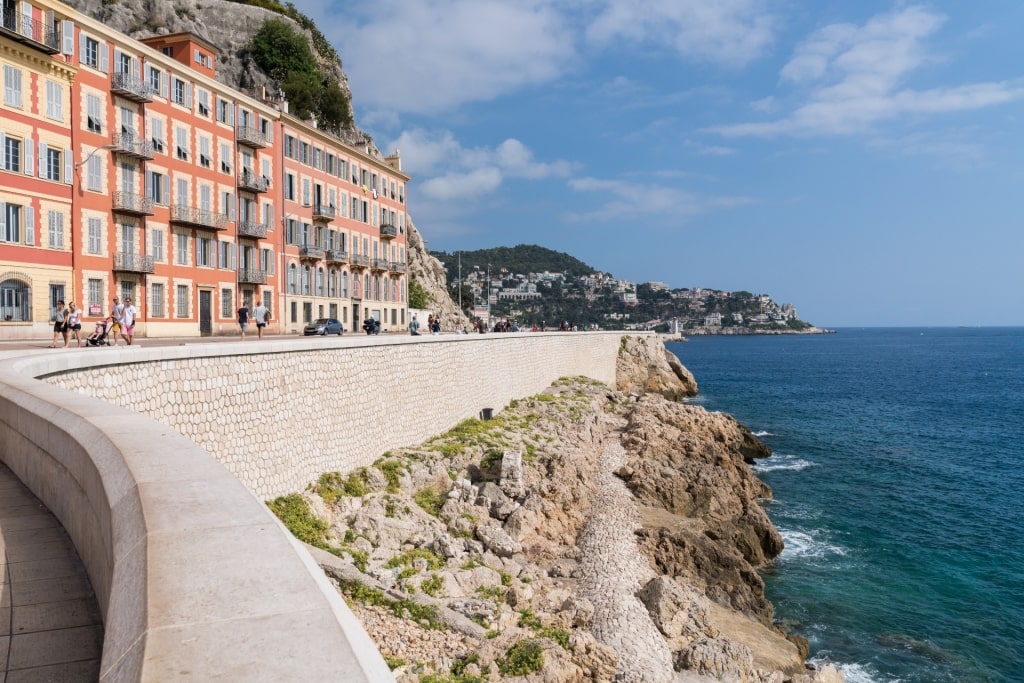
Promenade des Anglais
One of the nicest things to do in Nice is to go for a walk, or bike ride, down all or part of the Promenade des Anglais, which curves around the waterfront.
The Promenade des Anglais, lined with palm trees, got its name from English holidaymakers who would visit Nice in droves for the sun and sea. Funds raised in 1823, with a lot of money from the British community, helped pay for the esplanade’s construction.
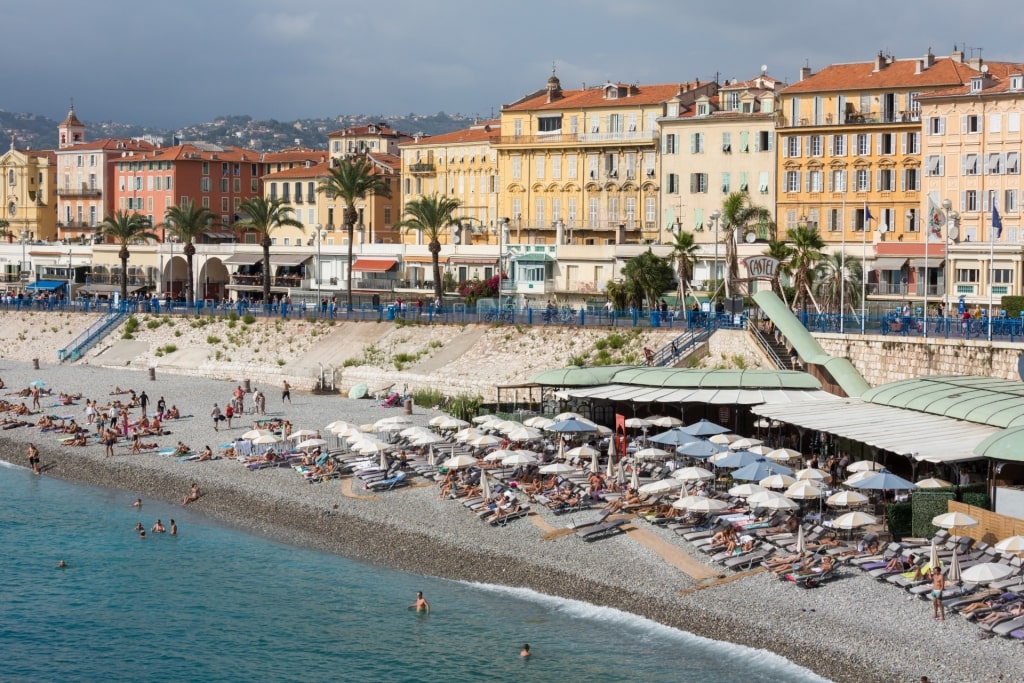
Castel Beach
Whitish pebble beaches next to the promenade, like Le Voilier Plage and Lenval Beach, are ideal for setting up a parasol and soaking in some rays after a dip in the water.
A stroll along the paved esplanade, over four miles in length, will take you past famous hotels, like Le Negresco, plus museums, outdoor sculptures, shops, cafés, and casinos, all of which showcase an eye-catching slice of Nice’s coastal allure.
Lay Eyes on Place Masséna’s Red-Infused Architecture

Place Masséna
Nice’s central meeting point, close to the Promenade des Anglais, is Place Masséna, marked by the red façades of the Italian-style neoclassical buildings lining the square.
Place Masséna will offer you easy access to the Old Town, Castle Hill, the Promenade des Anglais, the Promenade du Paillon (a long and narrow urban park), and the Jean Médecin shopping avenue.

Fontaine du Soleil
The Fontaine du Soleil is one of the main features of this handsome square. The fountain’s centerpiece is a large white sculpture of Apollo, the Greek sun god. Apollo watches over the square’s black and white checkered surface.

Villa Masséna
Try not to confuse the Place Masséna with Villa Masséna. The latter is located around eight or nine blocks west of the square. Villa Masséna and the Jardins du Musée Masséna are worth visiting too.
The Massena Museum, which is part of the villa, details the local history and contains artifacts related to Napoleon Bonaparte, including one of his death masks.
Take Advantage of Castle Hill’s Stunning Views
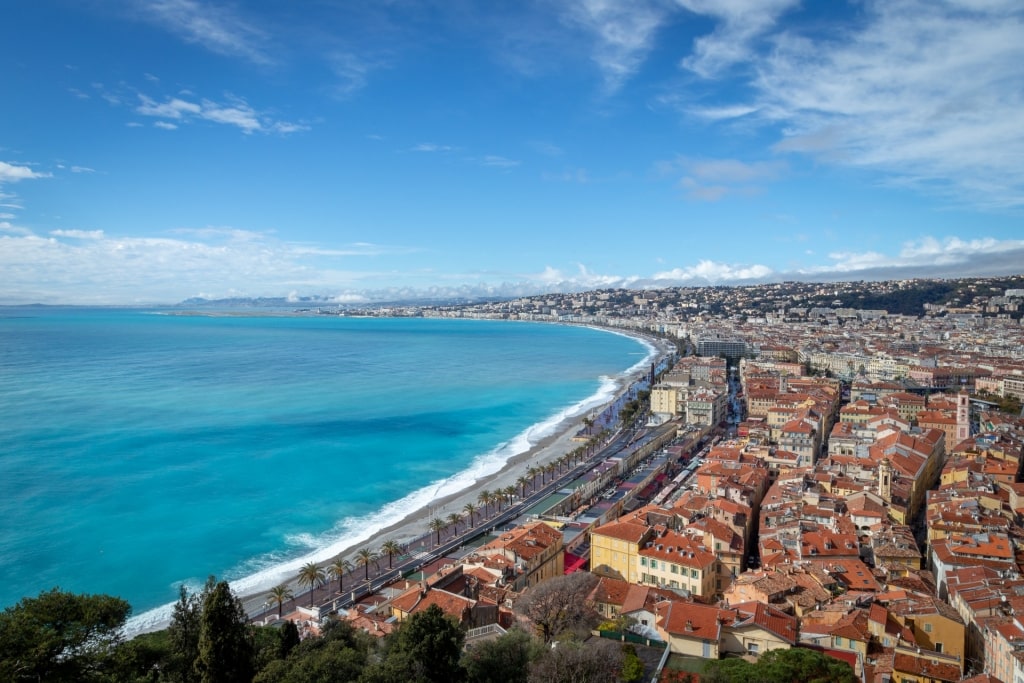
Castle Hill
One of the comeliest vantage points in Nice is Castle Hill. You can hike up the many stairs winding up the hill’s side, or take the elevator if you’re tired. Once you reach the top, you will be rewarded with stunning vistas of the city, the Promenade des Anglais, and the Mediterranean.
Nice’s Castle Hill Park, or the Parc de la Colline du Château, ironically, no longer has a castle. Once upon a time, a medieval citadel did stand here. But the “Sun King” Louis XIV demolished it in 1706, and alas, the castle is no more.
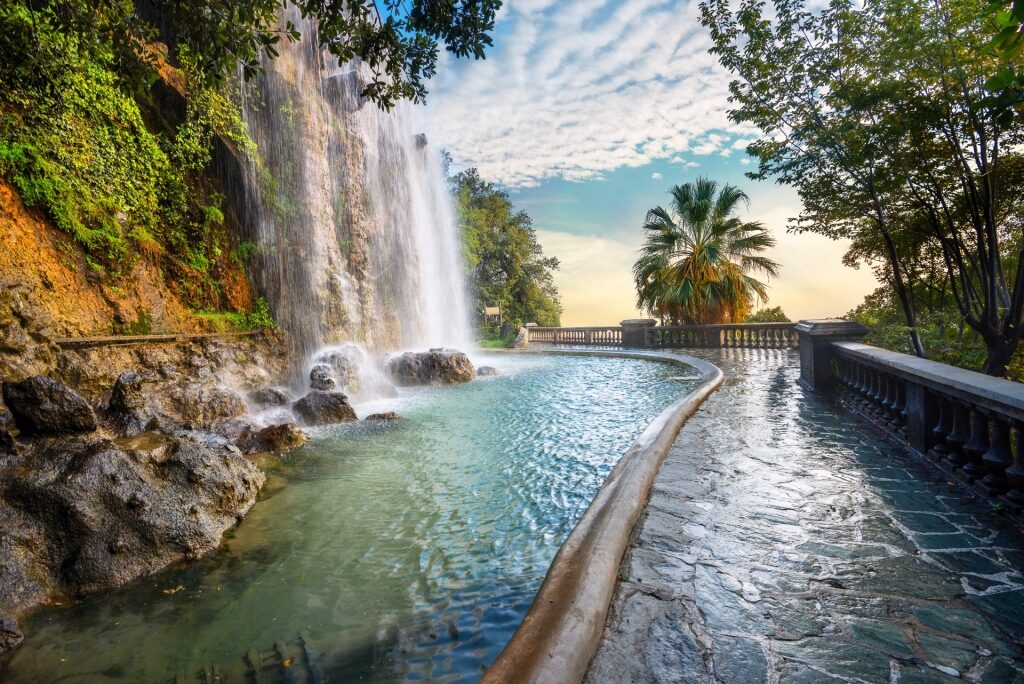
Castle Hill
These days, a trek up to the hill will take you past an attractive artificial waterfall. A green, grassy expanse, with a big playground for the youngsters, awaits you at the summit.
The elevator mentioned above, near the Old Town, will let you enjoy Castle Hill’s magnificent panoramas, minus the physical excursion that comes with the stairs.
Amble Past the Negresco Hotel
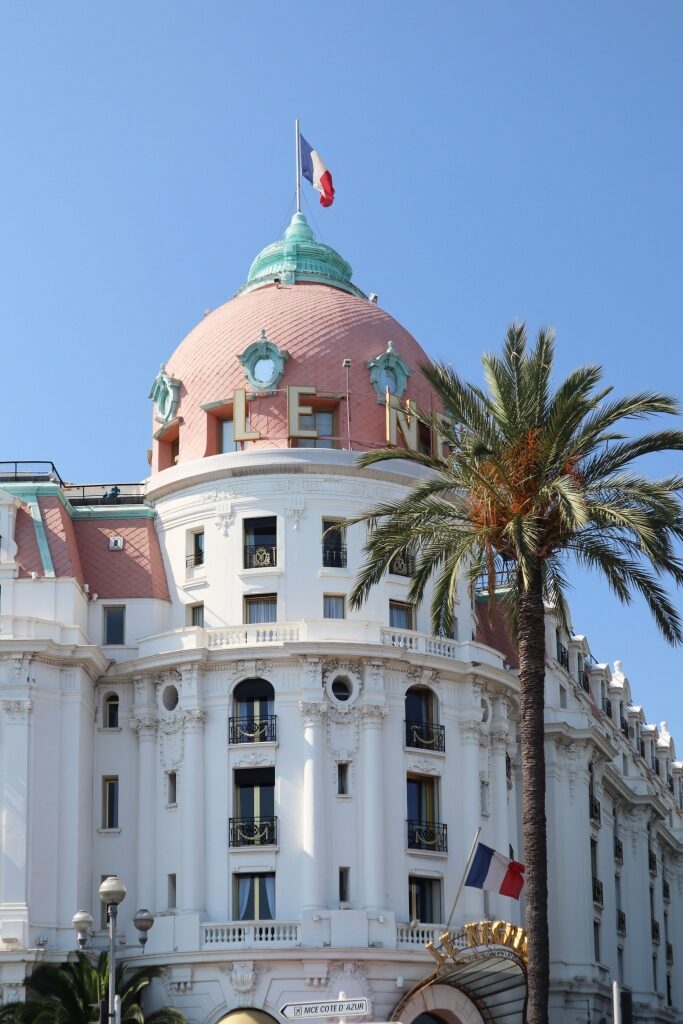
Negresco Hotel
Le Negresco Hotel is one of the most famous hotels in France. This Belle Époque hotel, with its distinctive white façade and large pink dome, fronts the Promenade des Anglais.
Commissioned and built by the Romanian hotelier Henri Negresco, Le Negresco opened its doors in 1913. Over the years, the hotel has been used as a hospital during WWI and has seen its ownership change several times.
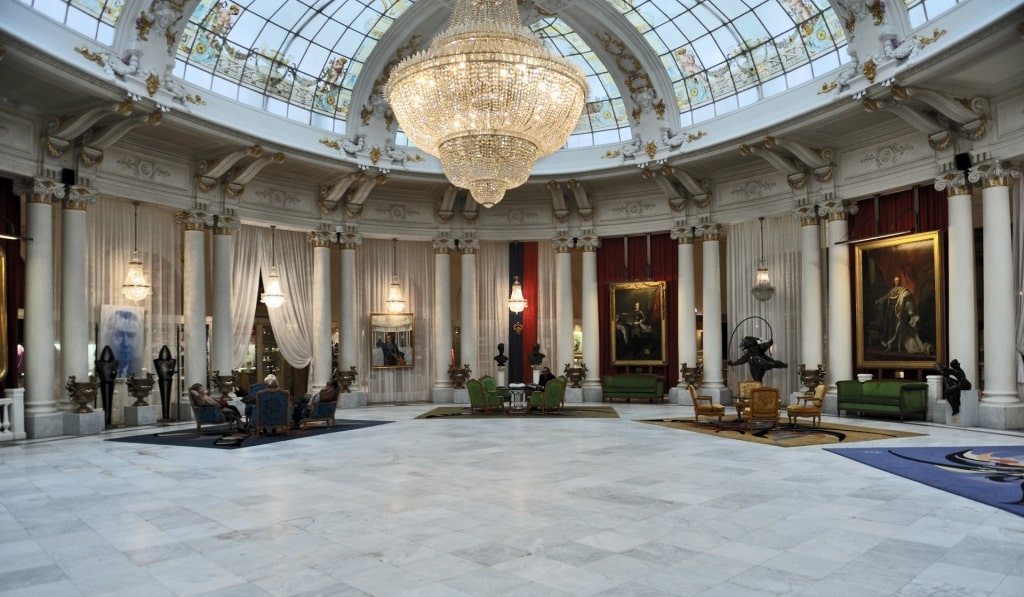
Negresco Hotel Photo by Cayambe on Wikimedia Commons, licensed under CC BY-SA 3.0
The lavishly decorated interior is something of a museum as well. Inside the Royal Lounge, you’ll find a splendid chandelier ordered by Tsar Nicholas II, plus a dazzling stained-glass dome designed by Gustave Eiffel.
Other French artworks, numbering in the thousands, and spanning the centuries, are displayed in areas available to the general public—even if you haven’t booked a room.
Enjoy the Local Cuisine

Socca
Nice, due to its French roots and its proximity to Italy, boasts a unique style of cuisine compared to the rest of the country. While in town, you’ll want to tuck into some of the local gastronomy that France is known for.
At the top of the list is the tasty, salted flatbread known as socca, made out of chickpea flour. Crispy, oven-baked socca can be found all over the city and is readily available as a snack to help you keep those hunger pangs at bay while you rove through town.

Salade Niçoise
If you’re into greens, try a Salade Niçoise (Niçoise is the name for people from Nice). This salad typically comes with anchovies, olives, and tomatoes, plus a tangy dressing made out of vinegar, shallots, mustard, and other flavorful ingredients.

Pissaladière
Pissaladière, a pizza-like pie with anchovies and onions, is another dish that sticks to its Italian roots. You can also opt for a Pan Bagnat, which is essentially a Salade Niçoise (with tuna or anchovies) stuffed between two pieces of bread.
If your taste buds lean toward the sweeter side, stop by one of Nice’s many gelaterias or ice cream parlors for a treat; a few standouts include Fenocchio, close to the Cours Saleya, where you can get your fill of delicious ice cream and sorbet, and Gelato D’Amore, just off the Promenade des Anglais.
Stroll Through the National Museum of Contemporary Art
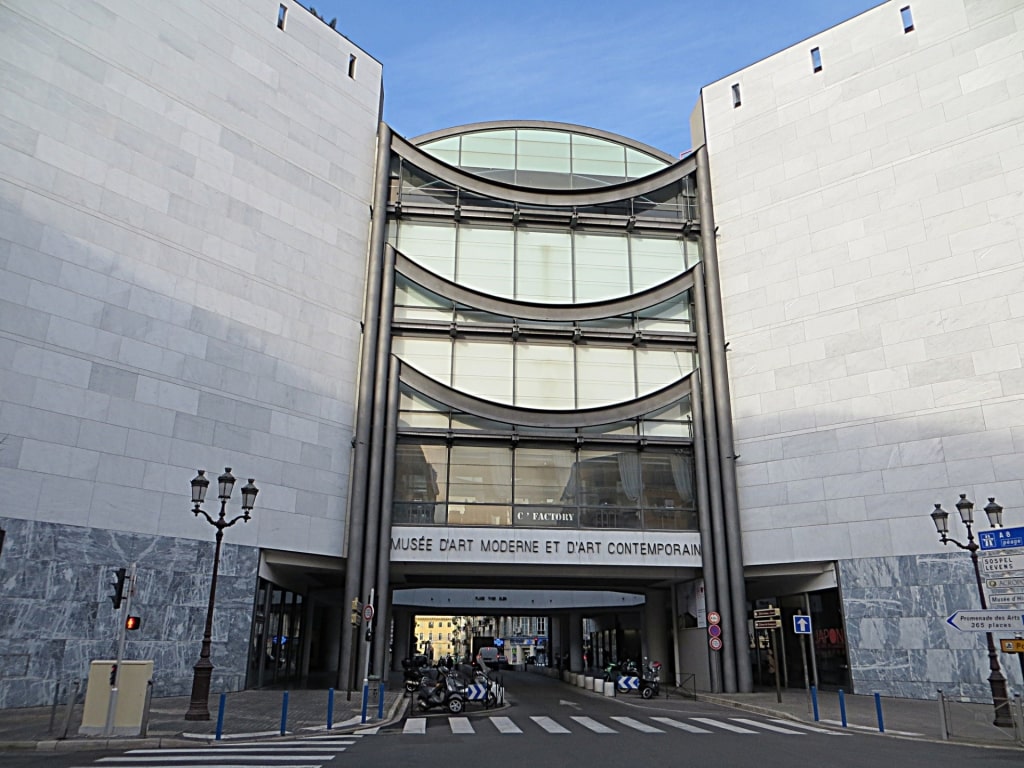
National Museum of Contemporary Art Photo by Mister No on Wikimedia Commons, licensed under CC BY 3.0
While Nice is a storehouse of classical French art and amazing architecture, you might be in the mood for something more modern. If this is the case, drop by the National Museum of Contemporary Art, one of the best museums in France.
Le Musée d’Art Moderne et d’Art Contemporain (MNAC), located in the center, is itself an attention-grabbing building, with huge, windowless concrete towers connected via arch-shaped passageways.
Inside, you’ll find a large collection of European and American pop art, French New Realism, and pieces adhering to the minimalist ethos.
Some notable artists whose works are on display at MNAC include Andy Warhol, Dennis Oppenheim, Francis Bacon, French sculptor Sacha Sosno, and Yves Klein.
The National Museum of Contemporary Art is a brilliant spot to visit during a rainy afternoon, where you can immerse yourself in the contemporary art scene.
Explore the Past in the Cimiez District
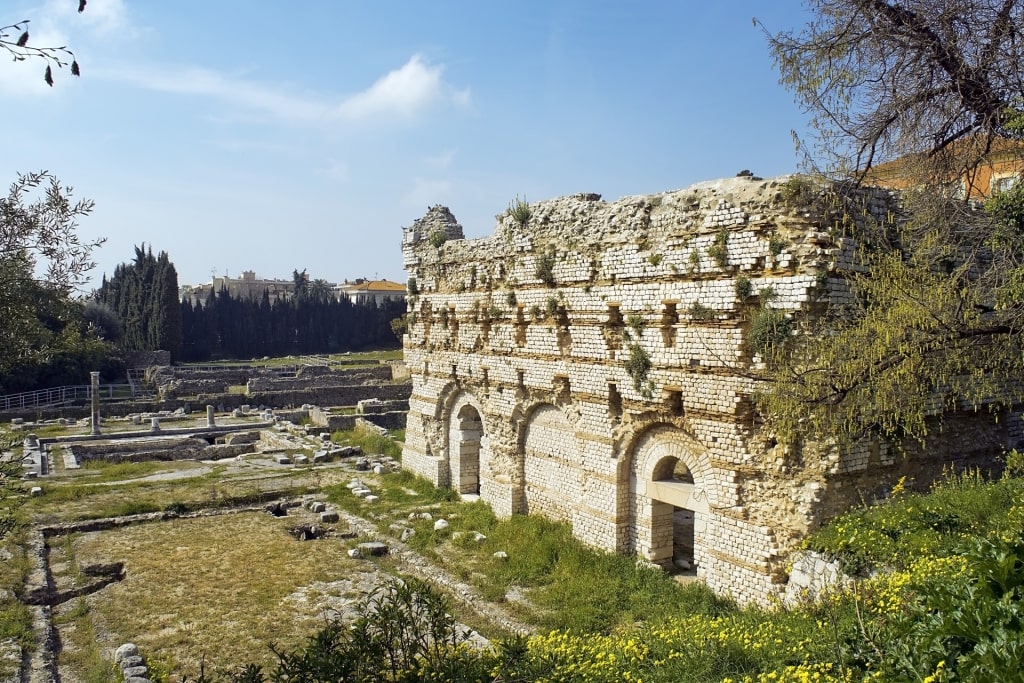
Cemenelum
A jaunt through the green and hilly Cimiez district, in the northern part of the city, will give you a chance to explore archeological finds dating back to Roman times, along with buildings and museums dating slightly closer to the modern era.
The Roman town of Cemenelum once thrived where Cimiez stands today. You can ramble around this open-field archeological site, and visit the excavated thermal baths. Visit the Musée et Site Archéologiques de Cimiez to learn even more about Roman life here back in the day.

Palais Régina
The 19th-century Palais Régina is another notable site in Cimiez. This grand-looking building, with its long façade and Belle Epoque interior décor, was once used by Britain’s Queen Victoria as her winter residence.
If you’re looking for a slice of spiritual history, call upon the Franciscan Monastery and the Franciscan Museum of Cimiez. The monastery dates back to the 14th century.
The compound features a lovely garden, while the museum hosts a large collection of religious art and artifacts, which will give you some insight into how monks lived in the past.
Get an Art Education at the Musée Matisse

Musée Matisse
Want to discover more about the French painter and sculptor Henri Matisse? If that’s the case, the Musée Matisse, located in Cimiez, should make your list of things to do in Nice.
The Matisse Museum is housed in the red Villa des Arènes and is home to an extensive collection of Matisse’s work, including drawings, paintings, and bronze sculptures.
You’ll also find items on display inside the villa that Matisse used in his everyday life. If you’d like to pay additional homage to the artist, visit Cimiez graveyard, where Matisse is buried, along with his wife Amélie.
Find Some Shade in Jardin Albert 1er
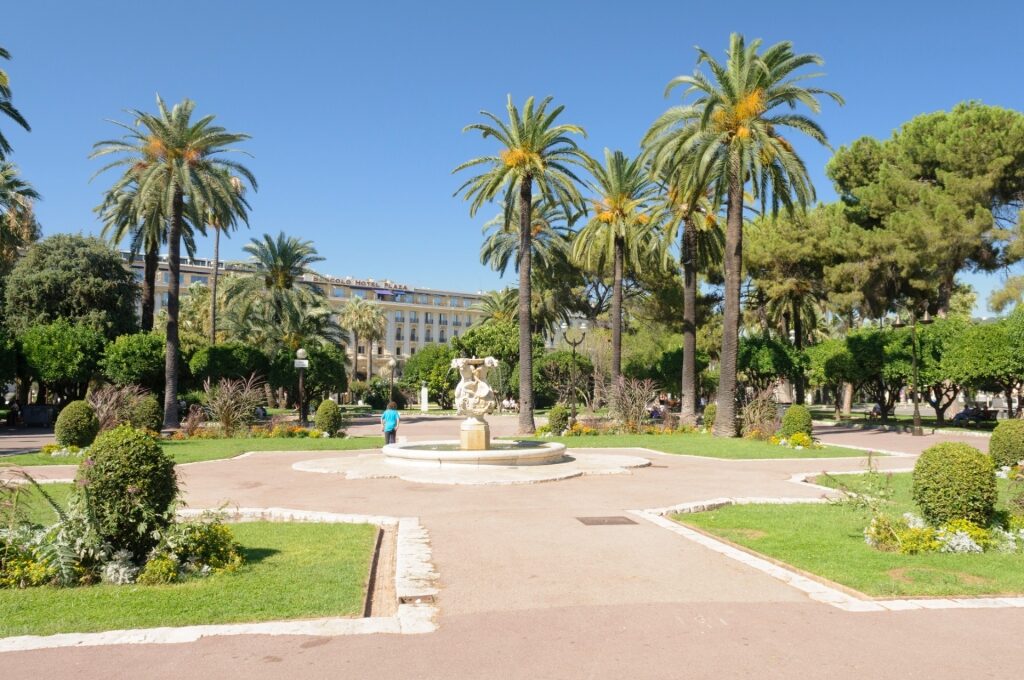
Jardin Albert 1er
With Nice, you tend to think of Mediterranean beaches, but Jardin Albert 1er shows off a much greener side. This historic park, established in 1852, was later named after Belgium’s King Albert I to honor his country’s resistance during WW1.
The garden is beside the Promenade des Anglais, so you can enjoy Mediterranean views while strolling among tall palm trees. Herbs and colorful flower beds, as well as other plants lend their variety to the experience.
During summer in France, an open-air theater offers entertainment, including music and cultural events. The huge statue at the southern entrance representing winged Victory marks the centenary of Nice’s incorporation into France in 1793.
Enjoy a Wine Tasting at Cave Bianchi
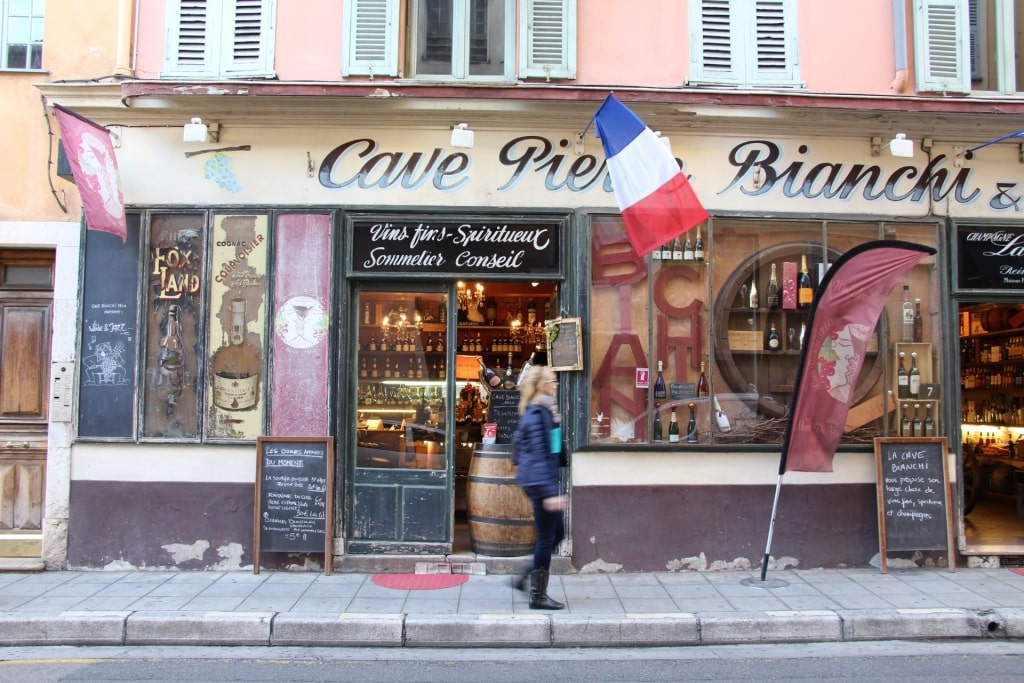
Cave Bianchi Photo by Fred Romero on Flickr, licensed under CC BY 2.0
To explore local Provençal wines, where better than this historic wine shop dating all the way back to 1860? Its selection of wines makes Cave Bianchi a noted destination for wine-lovers.
It has been run by generations of the same family and the staff have decades of knowledge. As well as local wines, they can guide you through their much wider range.
Cave Bianchi also stocks spirits, Champagnes, and local gourmet foods. The shop’s atmospheric interior is worth a look in itself, with its wooden shelves and vaulted cellar.
Study the Art in Musée des Beaux-Arts de Nice
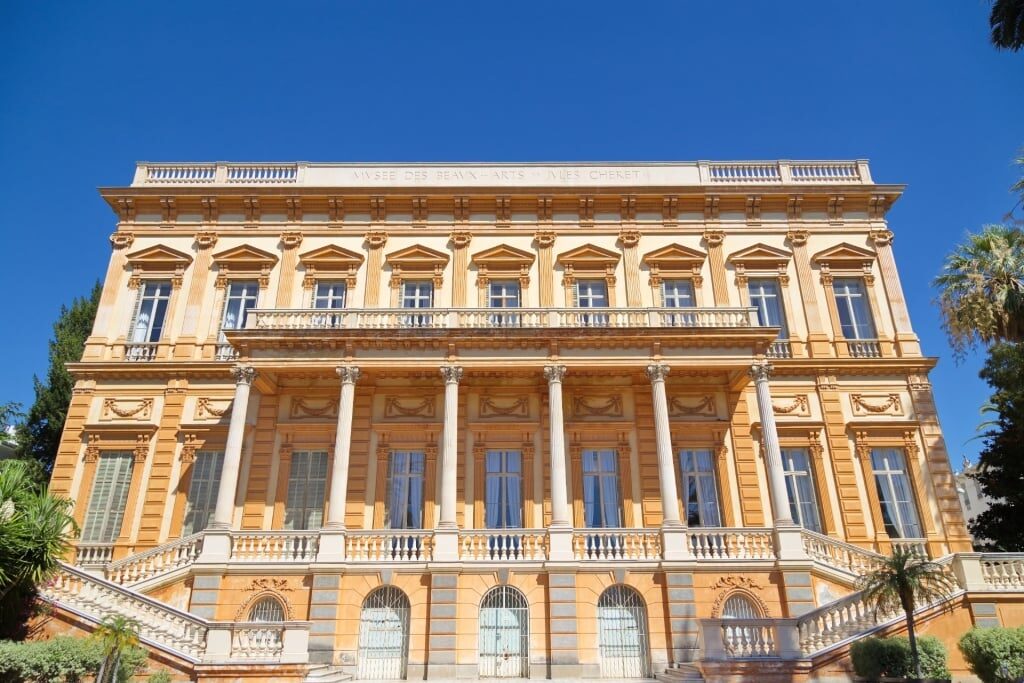
Musée des Beaux-Arts de Nice
This wonderful art collection is housed in an equally lovely Neo-Renaissance villa. Originally designed in 1880 for a Russian Princess, it was finished to the original plans by American industrialist James Thompson.
The Thompson family did change the interiors to a late-Victorian style. These now display an art collection that includes works by Edgar Degas, Jean-Honoré Fragonard, and Auguste Rodin.
The museum focuses on 19th-century French art but has French and international works from the 16th to the 20th century. Works by local artists from Nice and Provence generally are also a strength, making a visit here one of the best things to do in Nice.
Explore the Parc Phœnix
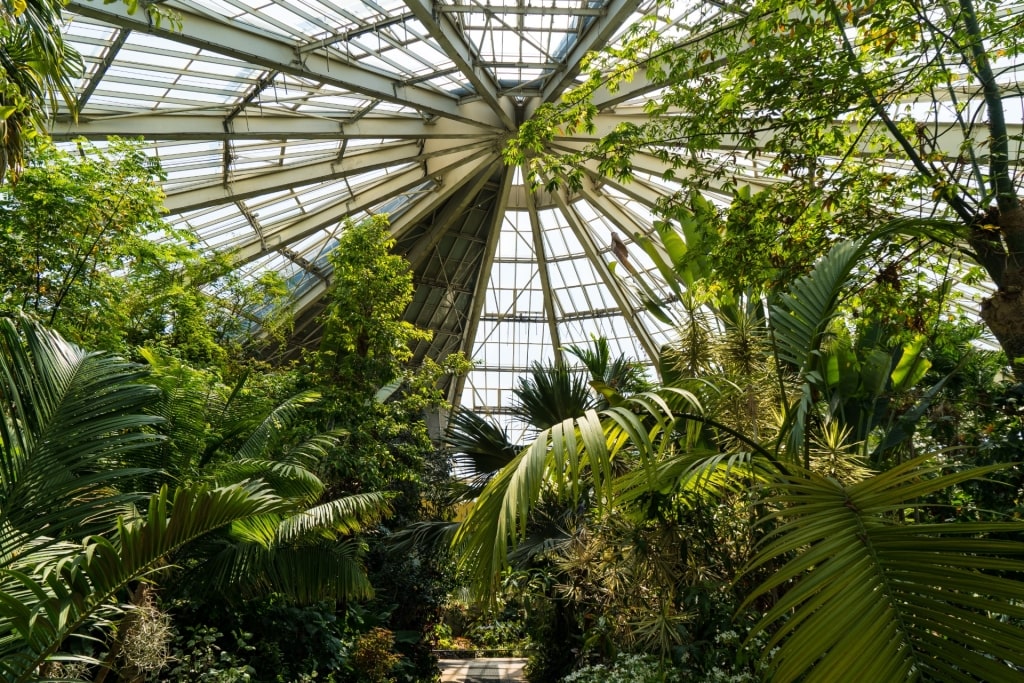
Parc Phœnix
Parc Phoenix is a botanical garden and zoo built around a large lake. The animal life is mostly birds, including flamingos and other exotic birds, as well as reptiles.
The park’s centerpiece is one of the largest greenhouses in Europe. Called “The Green Diamond”, it holds a diverse collection of tropical and subtropical plants.
There are several themed gardens, including a Mediterranean one and a bamboo forest. If all that is not enough, there is even the Musée des Arts Asiatiques to discover.
Wander the Gardens of Villa Ephrussi de Rothschild
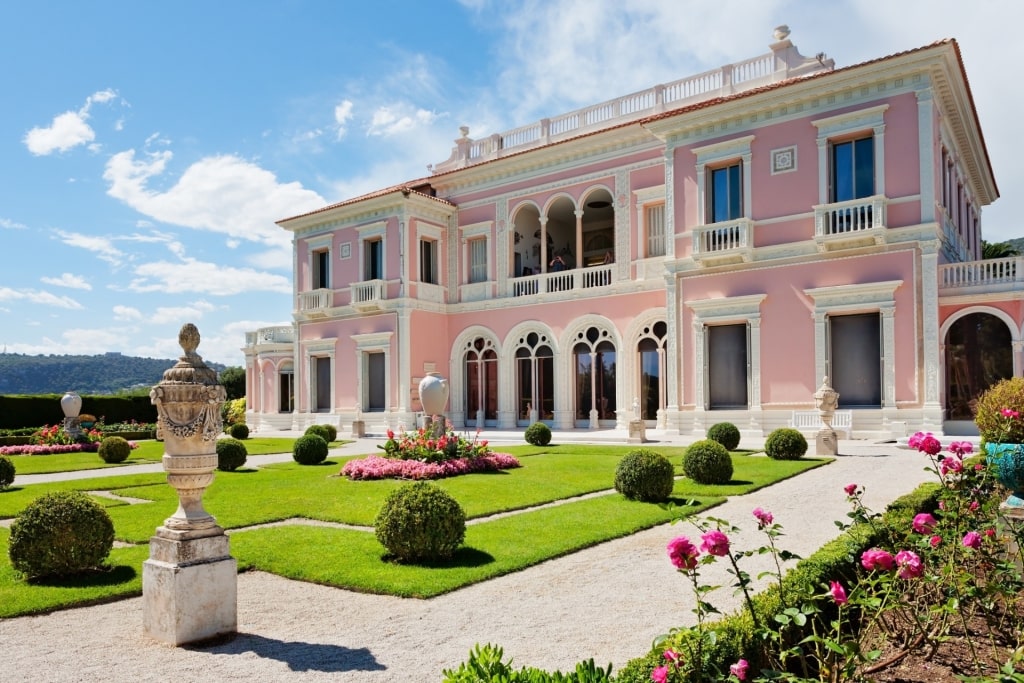
Gardens of Villa Ephrussi de Rothschild
This hilltop seaside villa once belonged to Baroness Béatrice de Rothschild of the famous banking family. On her death in 1934, it was bequeathed to the Académie des Beaux-Arts as a public space.
The villa is renowned for its amazing architecture, blending styles that include Italian Renaissance, Spanish, and French. Its nine landscaped gardens also include spaces with French, Spanish, Florentine, and Japanese themes—with the musical fountains being an added attraction.
Painted in vivid pink, the villa houses an exquisite collection of art and antiques. This is based on the Baroness’s own collection of Old Masters, rare porcelain, and classic furniture.
Take in the View from Fort du Mont Alban
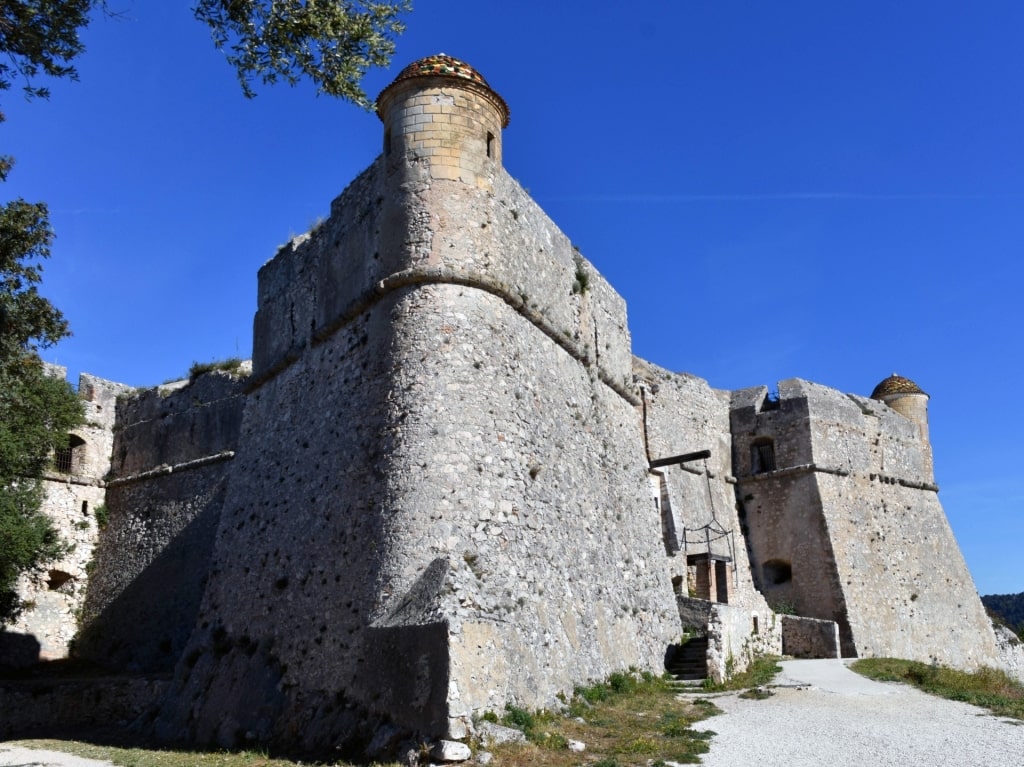
Fort du Mont Alban
Fort du Mont Alban was built in 1557 on top of the mountain from which it takes its name. It defended the harbor of Villefranche-sur-Mer, one of the deepest natural harbors in the Mediterranean.
Its construction was a response to the Siege of Nice in 1543, when the city—then belonging to the Duke of Savoy—was sacked by the French. Typical of its time, it is a square plan with a bastion at each of its four corners.
The fort’s strategic importance can be appreciated in the views from its ramparts. While the fort itself is often closed, its main attraction is this spectacular panorama of Nice, Villefranche-sur-Mer, and Cap Ferrat.
Cool Off at Cascade de Gairaut
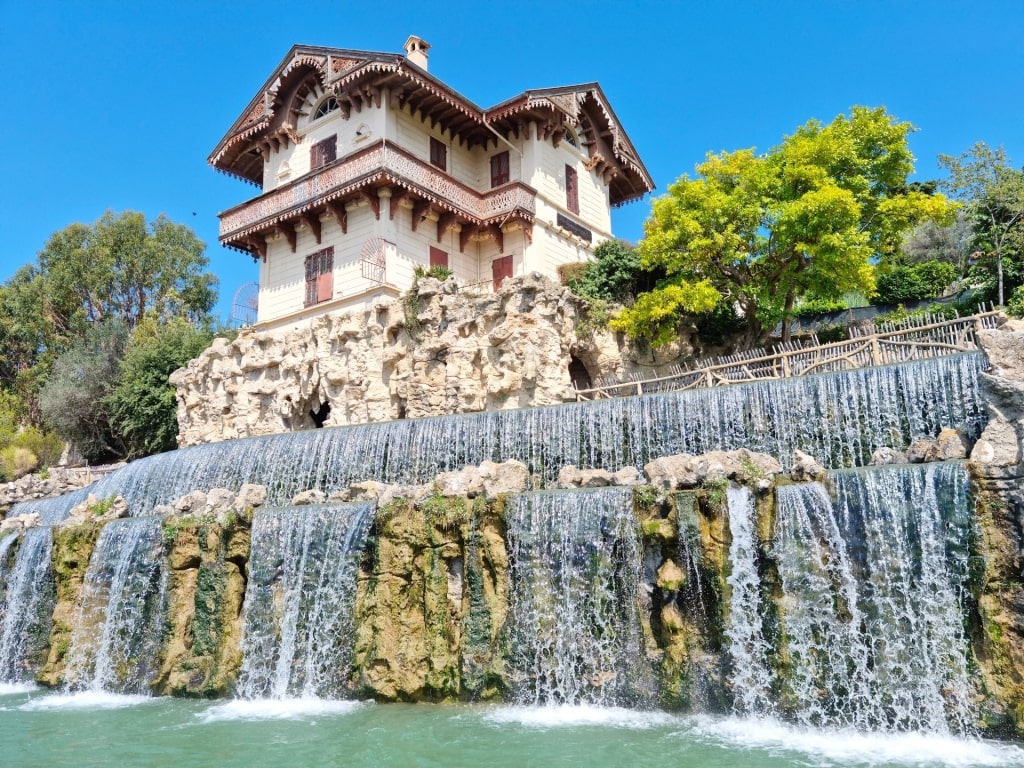
Cascade de Gairaut
The Cascade de Gairaut is part of a major water supply system built in 1883 to bring water from the Vésubie River. While the waterfall is impressive in itself, it’s also a symbol marking a major stage of Nice’s growth into an important city.
The waterfall is in the ornate Belle Époque style typical of the period, complete with a fake Swiss chalet. It drops about 130 feet and sits in a garden with walking paths.
As a cool respite from the Mediterranean heat, it’s a popular spot in summer. You’ll find it in the Gairaut neighborhood in northern Nice.
Be Awed at Marc Chagall National Museum
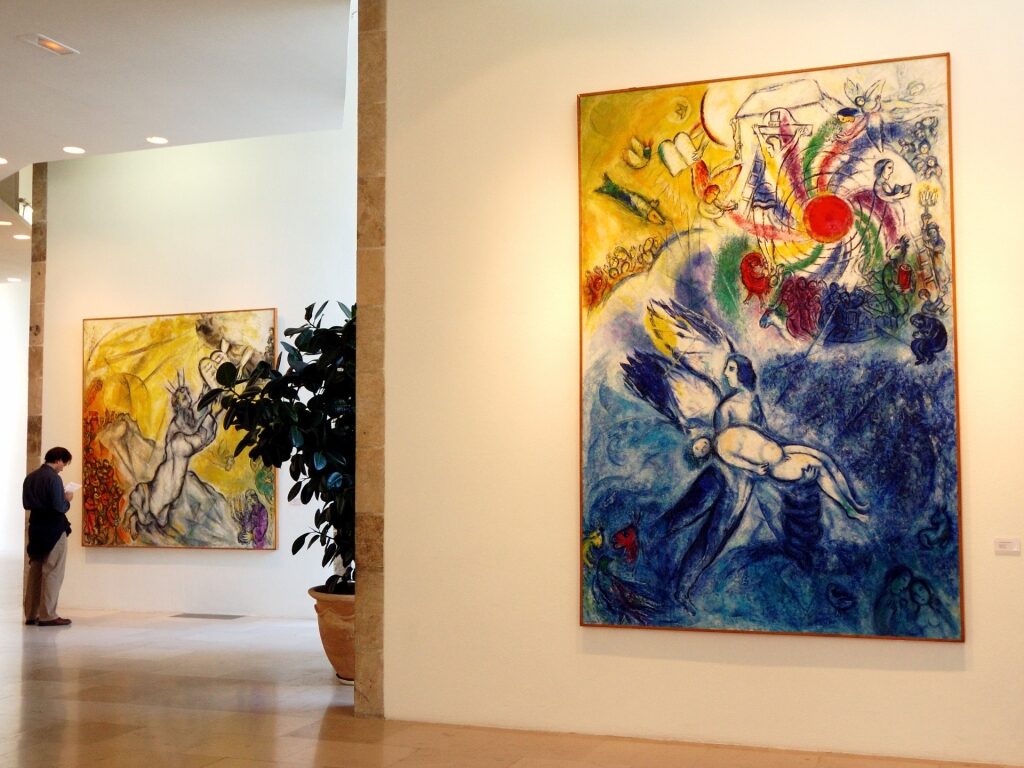
Marc Chagall National Museum Photo by Rosino on Flickr, licensed under CC BY-SA 2.0
Artist Mark Chagall offered his “Biblical Message” series of 17 paintings to the French State in 1966. That act eventually led to the opening of what is now the Marc Chagall National Museum just nine years later.
Chagall died in 1985, when 300 further works were given to the museum. Many of these, and other acquisitions since, focus on his religious and spiritual art.
You’ll find stained glass and sculptures, as well as drawings and paintings. The building is by André Hermant, a student of Le Corbusier, and the extensive gardens form a perfect, peaceful backdrop.
Read: South of France Itinerary
Sip a Coffee in Place Garibaldi
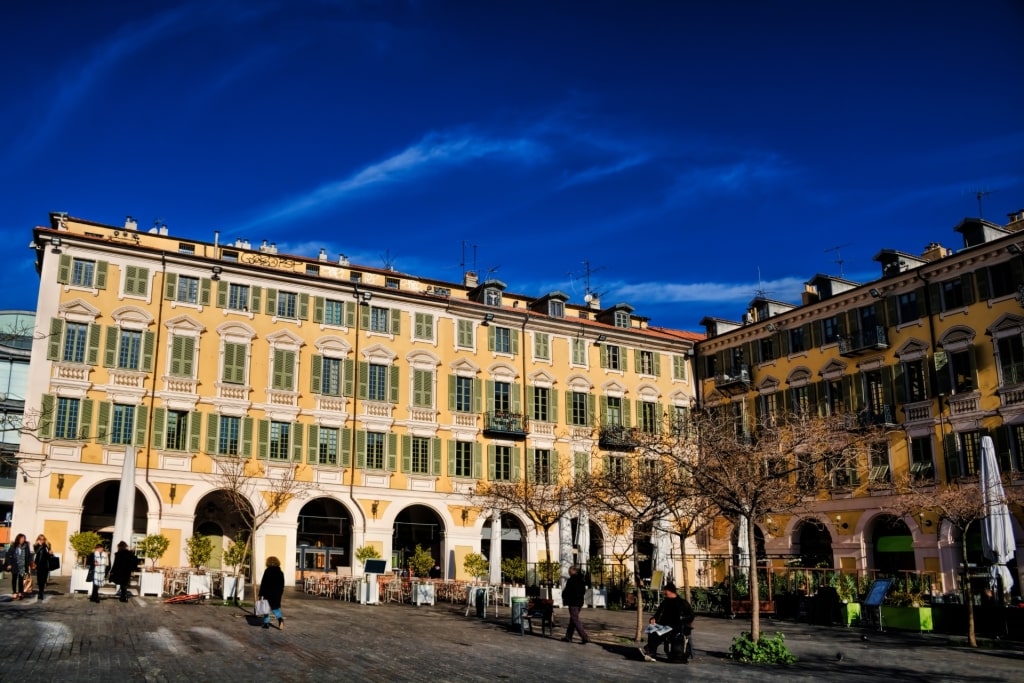
Place Garibaldi
Place Garibaldi is a major square on the eastern side of Vieux Nice, the Old Town. It’s named for Giuseppe Garibaldi, the Italian national hero born in Nice in 1807, whose statue stands at its heart.
The plaza was laid out in the late 18th century as part of an urban expansion plan. With its surrounding arcaded buildings, painted in bright yellow, it’s a showpiece of Baroque architecture.
Many cafés and restaurants take full advantage of the square’s pedestrianization. It’s a photogenic gathering place to hang out with a drink and watch the world go by.
Listen to the Music in Basilique Notre-Dame de l’Assomption
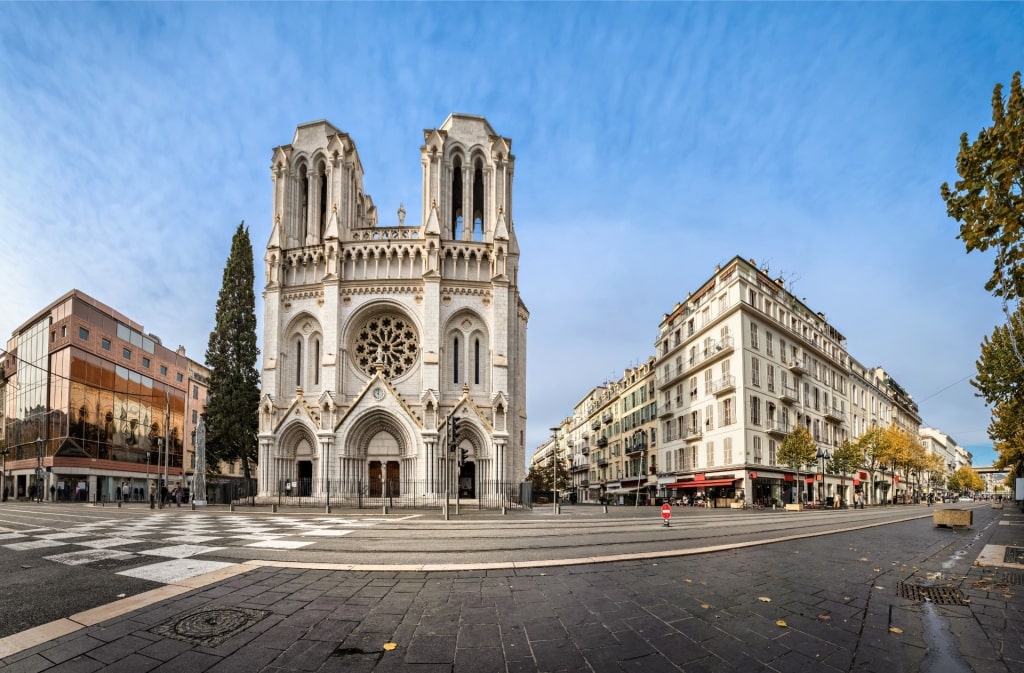
Basilique Notre-Dame de l’Assomption
The Basilique Notre-Dame de l’Assomption is the largest church in Nice. With its bright white exterior and two 213-foot-high square towers, it is a prominent city landmark.
The basilica sits on Avenue Jean Médecin, most famous for its shopping. Finished in 1868, it is built in the Neo-Gothic style typical of that time.
The soaring vaulted interior is lit by ornate stained glass windows. The excellent acoustics are put to good use in regular musical events, including organ and choral recitals.
See the Medieval Village of Èze
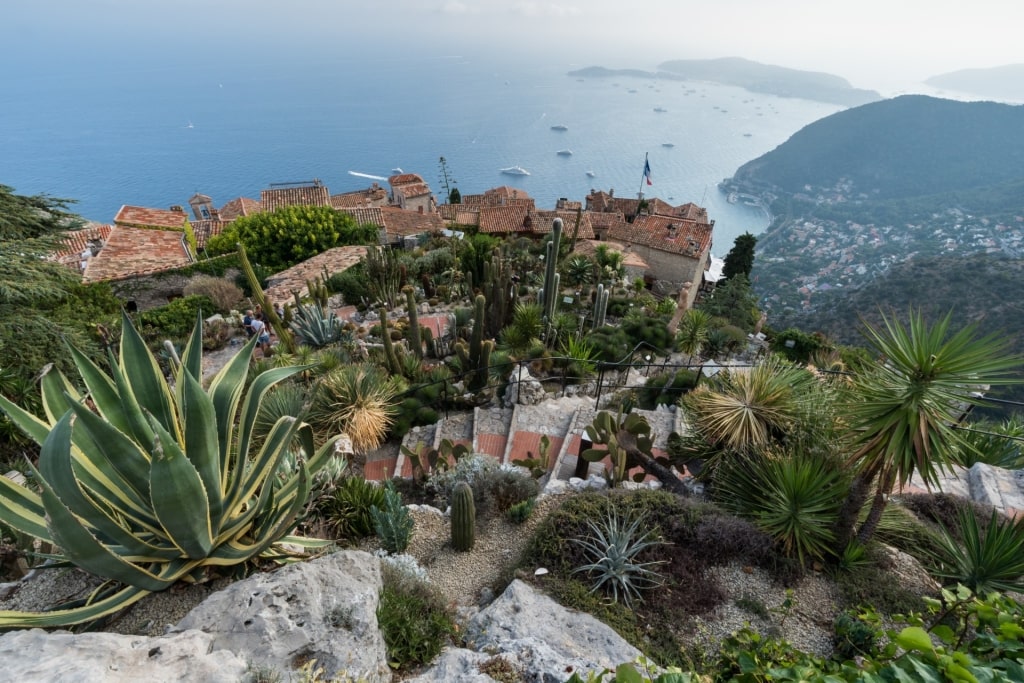
Èze
Only 20 minutes from Nice, the hilltop village of Èze sits at 1,407 feet. One of France’s most beautiful small towns, its views over the Côte d’Azur are amazing.
That view, the narrow winding streets, and pretty stone houses have made Èze popular with visitors for centuries. A famous past resident was Nietzsche and you can walk the path down to Èze-sur-Mer where the philosopher found inspiration.
Plenty of artisan shops and several notable restaurants add even more to Èze’s appeal. A final delight is the Jardin Exotique, strong in cacti, succulents, and sculptures.
Photograph Maison de la Treille
Treille means “vine” and the greenery cascading down one wall of this old house makes it obvious how it won its name. With its butter-yellow walls and corner setting, it’s one of the most photogenic sights in Nice.
Originally a tavern, the house was painted by artist Raoul Dufy in 1930. You can see his famous view of it in the Musée des Beaux-Arts.
Dufy shows it decorated during Nice’s annual May Festival. The house holds a special place in local hearts for its historic place in preserving the Niçard dialect and culture.
Delight in the Old Port
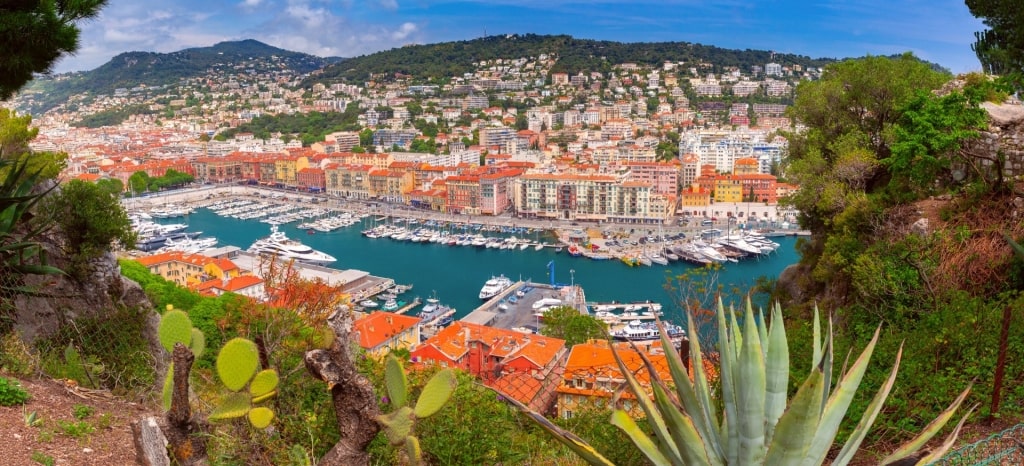
Old Port
Lined with handsome yellow and ochre buildings, Nice’s Old Port is both picturesque and busy. Filled with small yachts and fishing boats, it’s still a working harbor, albeit less so than in former centuries.
Built in 1752 and “modernized” in 1829, its quays are now lined with seafood restaurants, cafés, boutiques, and art galleries. You have a great overview from the rooftop terrace of Caserne Lympia, a former prison/barracks that is now a cultural center.
From May through September, enjoy the free “Lou Passagin” service shuttle across the harbor mouth. It’s a silent, solar-powered, electric version of the traditional “pointu” or “barquette marseillaise” fishing boat.
Browse the Marché aux Puces
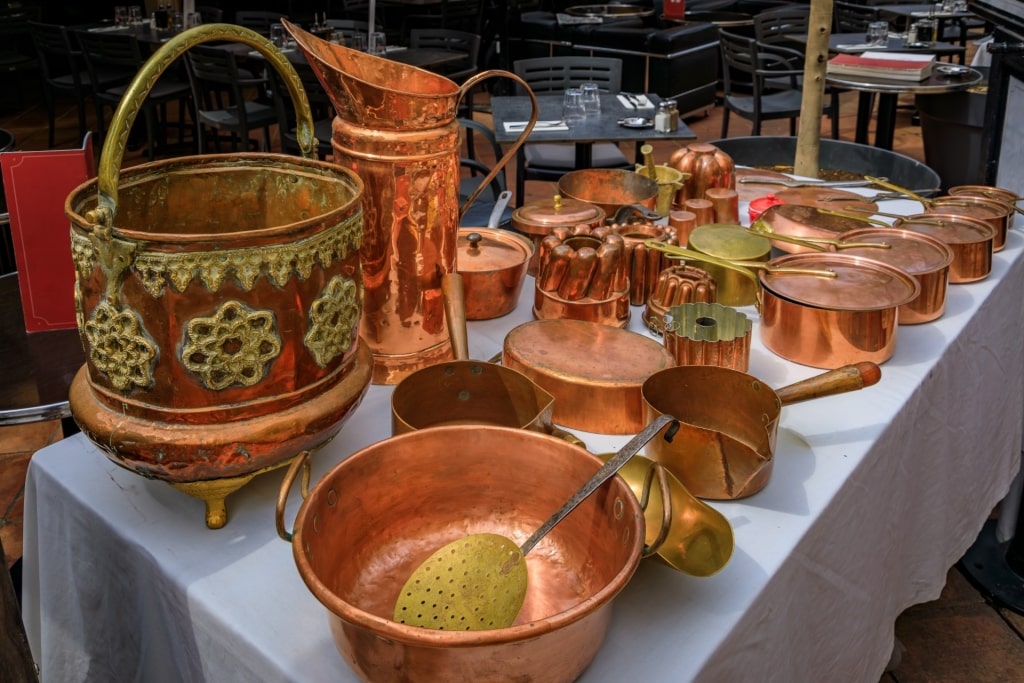
Marché aux Puces
While in the Old Port, don’t miss the quirky Flea Market, held every day except Monday. It’s beloved by everyone from fashion lovers looking to repurpose old clothes to antique dealers hunting rare finds. If you love vintage, spending time here is one of the best things to do in Nice.
The market was originally set up to help widows and veterans after World War I. Now more formalized on Quai Papacino, it’s still more anarchic than the bigger one on Cours Saleya.
You’ll find everything from furniture and household goods, to paintings and books. Even if you’re not buying, it’s still a great place to soak up the atmosphere—and see some beautiful objects.
Read: Best Places to Shop in France
Walk Around the Historic Russian Cemetery
After their country’s Revolution in 1917, Nice became a refuge for many Russian aristocrats. The Caucade Cemetery is dedicated to Grand Duke Nicolas Alexandrovich.
The Russian section—open four days a week—holds the tomb of Princess Yourievska, daughter of Tsar Alexander II. Princess Kotschoubey, whose palace is now the Musée des Beaux-Arts, is also buried here.
Notable burials elsewhere in the cemetery include sexologist Dr. Magnus Hirschfeld and jeweler Alfred Van Cleef. While you stroll around this peaceful spot, high above Nice, you’ll also enjoy amazing views.
Enjoy a Picnic on the Beach
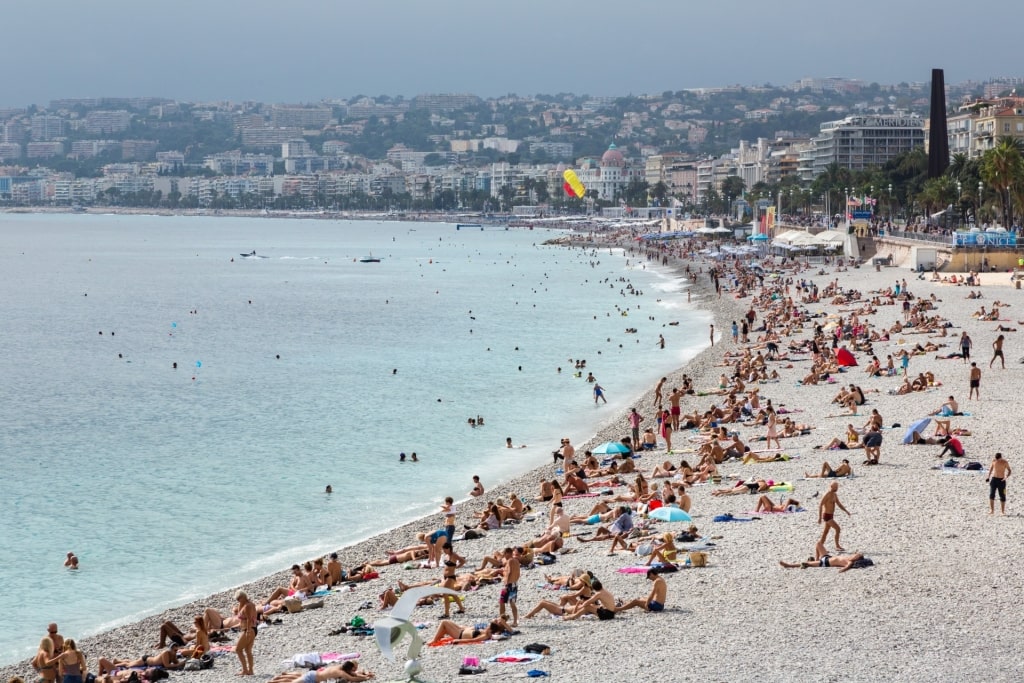
Beach in Nice
You can’t go to the Côte d’Azur without spending time on a beach and taking a dip in the warm Mediterranean. Walking on the Promenade des Anglais, you’re looking out over many of the best beaches along the seashore.
Most of the beaches in Nice are made up of pebbles, called “galets” in French. You’ll need beach shoes to walk them and a rented sun-lounger to fully enjoy the experience.
You will notice that topless sunbathing is no longer as fashionable as it once was in France. However, one thing that hasn’t changed is the custom of bringing a picnic to the beach—one well worth adopting.
Give Your Nose a Thrill in Grasse
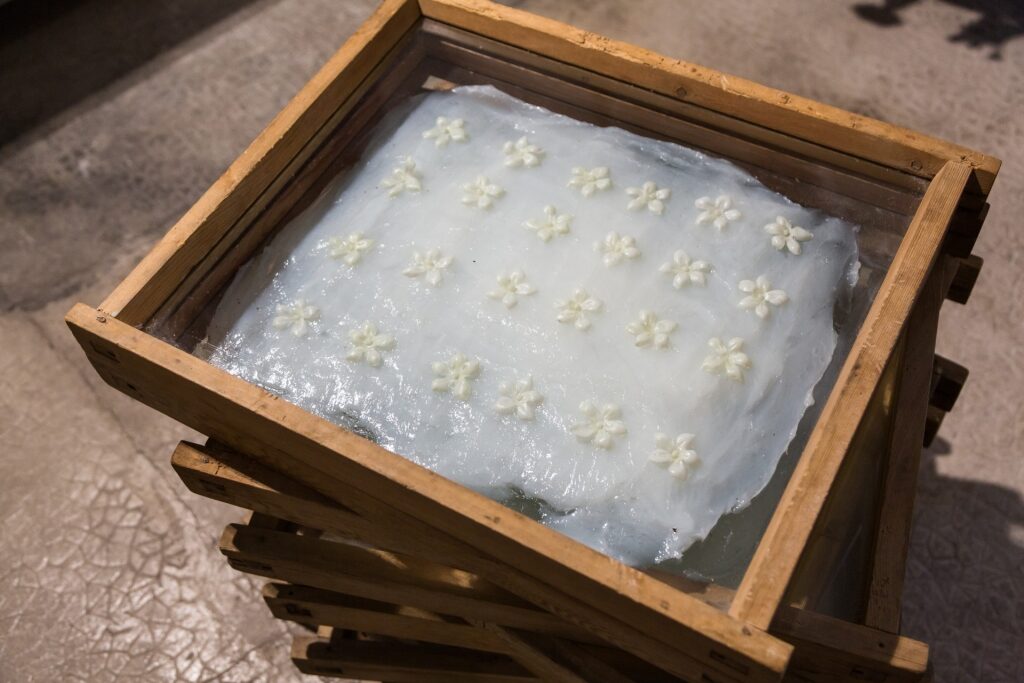
Fragonard, Èze
Grasse, the “Perfume Capital of the World”, is less than an hour from Nice. With factories offering tours and workshops, it’s a must-visit for any lover of scent.
The area enjoys a unique microclimate, perfect for flowers such as jasmine, rose, and lavender. That has made the charming old town a major perfume center since the 16th century.
If Grasse is too far to travel, you can create your own scent during workshops elsewhere. Molinard in Nice and Fragonard in Èze are among the perfume houses offering the experience.
Be Impressed by the Opéra de Nice
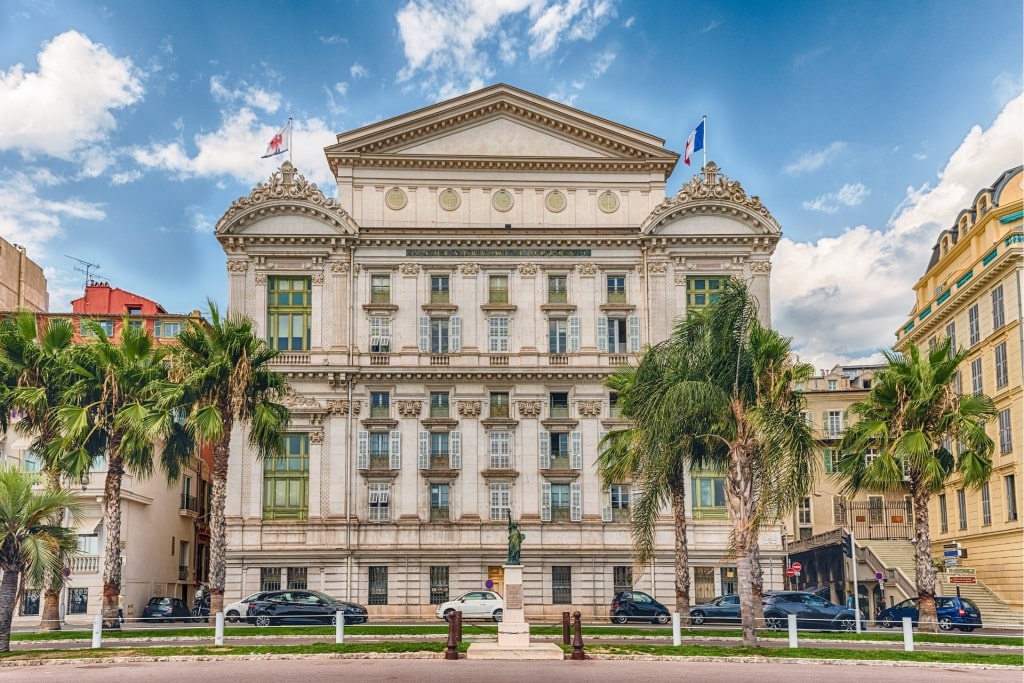
Opéra de Nice
Nice’s opera house is another landmark near the Promenade des Anglais. Besides opera, it also hosts ballet and classical music.
The grand neoclassical facade, featuring columns, sculptures, and intricate detailing, gives you a taste of the wonders inside. Built in 1885, the opera house has been central to Nice’s cultural life ever since.
If you can’t enjoy an evening taking in a performance, there are guided tours to at least see the lavish auditorium. It’s in classic style, dominated by a massive chandelier.
Find Inspiration in The Museum of Naïve Art
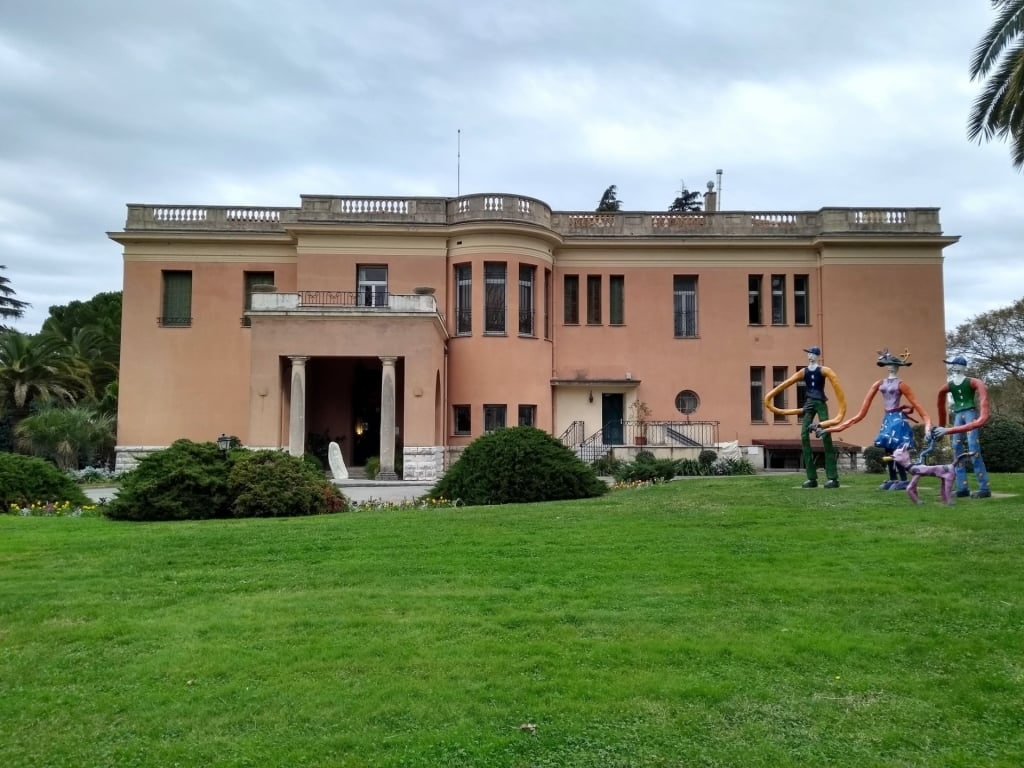
The Museum of Naïve Art Photo by patrick janicek on Wikimedia Commons, licensed under CC BY 2.0
Officially the Musée International d’Art Naïf Anatole Jakovsky, this museum showcases naïve art from around the world. It’s in Château Sainte-Hélène, a picturesque 19th-century villa in Nice’s Fabron district.
The core of this collection of simple, colorful art belonged to collector Anatole Jakovsky. First set up in 1982, it now houses more than 600 works by some 200 artists.
In the house and garden, you’ll find paintings, drawings, and sculptures from artists such as Henri Rousseau and André Bauchant. There is even one piece by American folk artist Grandma Moses, while temporary exhibitions regularly bring other surprises.
Drive Along the Côte d’Azur
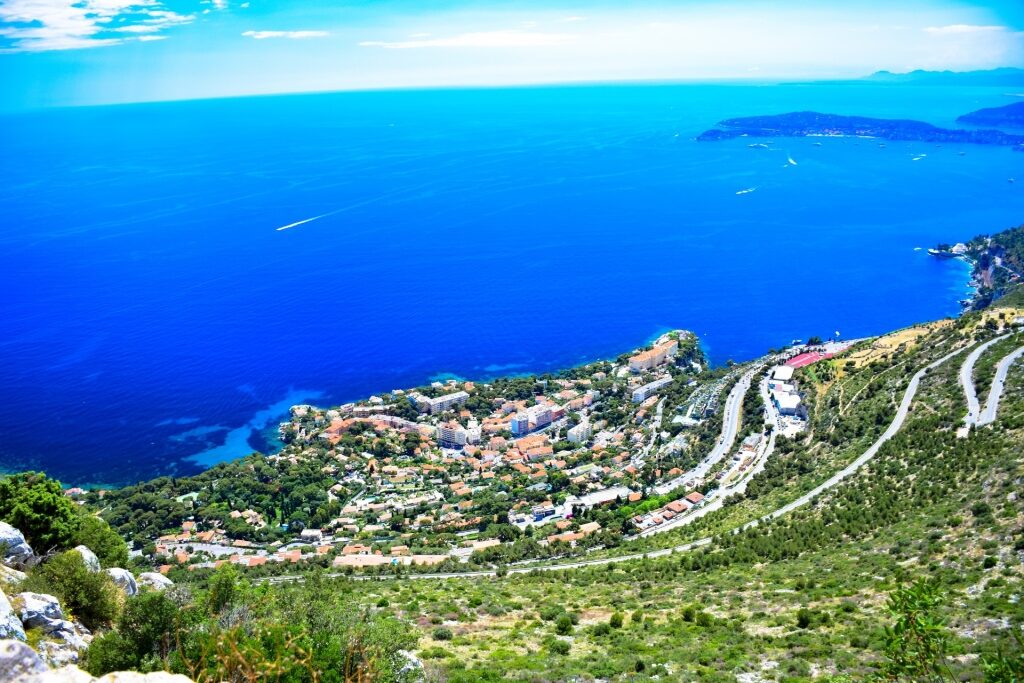
Middle Corniche
There are three main panoramic Corniche roads between Nice, Monaco, and the nearby Italian border. Full of tight bends with breathtaking views, they are instantly familiar from movies and glossy car adverts.
If you are not brave enough to drive them yourself, you can enjoy them on guided tours. The Lower Corniche—“Basse Corniche”—runs along the coast to Villefranche-sur-Mer and Menton.
The Middle Corniche—“Moyenne Corniche”—will take you to the medieval village of Èze. The spectacular Upper Corniche—“Grande Corniche”—is the road into the mountains that is most used in motor rallies and cycling events.
Read: Best Places to Visit in the South of France
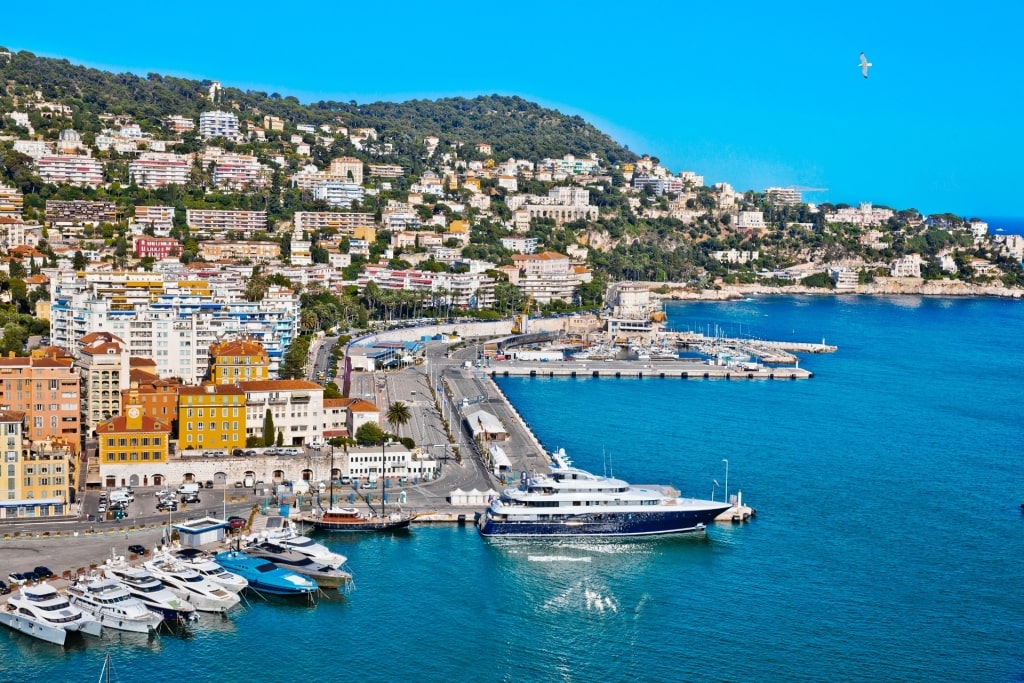
Nice
Explore the city on a cruise to Nice with Celebrity Cruises. Browse itineraries on our website and book your getaway today.
